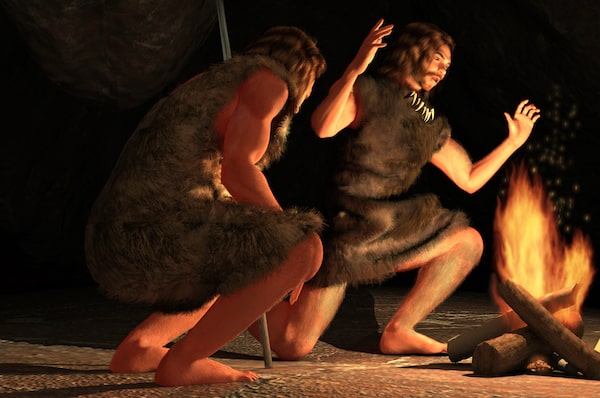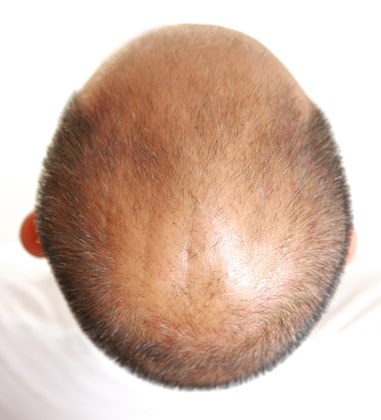Evolution of Baldness
Hair loss can occur for several reasons including the aging process, genetics, the taking of certain medications, autoimmune conditions, or hormone imbalances. Typical male pattern baldness or male pattern hair loss (MPHL), can appear on the scalp as patterned hair loss as well as patchy and/or circular crown bald spots. Since patterned hair loss is a very common phenomenon, there are some people in the scientific community who view the loss of hair on the scalp as part of the evolutionary process that might have influenced the survival of humans.

Are they correct or are they sharing crazy theories? Let’s examine the reasoning behind the idea of balding being essential to the survival of humans.
Showing More Skin – A Key to Survival?
David Muir, of the United Kingdom, feels a bald head might provide an evolutionary advantage that protects from illnesses caused by low vitamin D levels. He referred to bald heads as “personal solar panels” that perform photosynthesis of vitamin D in the skin from ultraviolet B rays that come from sunlight. As people moved north in prehistoric times, they started losing necessary skin pigmentation that compensated for lower amounts of UVB rays at a northern latitude during the winter. A loss of skin pigment could have been sufficient for a while but, as the migration north continued, sun exposure became scarcer. Bald people would have an advantage due to their ability to synthesize vitamin D through the top of the scalp which had greater exposure to the sun.
Respect My Wisdom and My Baldness!
 Have you ever noticed how bald people stand out in a group of younger and less bald people? Donald Windsor of Norwich, New York hypothesized that male baldness may have had a survival advantage as bald people could have easily been spotted in a crowd of people of diverse ages. Since patterned baldness is usually seen above the age range of the early twenties, a bald head could have been seen as a sign of age-related seniority. Archeologic research shows life expectancy was about 20-30 years a few thousand years ago. Even at the beginning of the nineteenth century, people all over the world did not have a life expectancy longer than 40 years. That means the number of bald people in a tribe was exceedingly rare. Balding was always seen as being equal to seniority and wisdom. The youngest in the tribe would respect and protect the seniors in the group. It has also been argued that grey or white hair could have provided the same benefit.
Have you ever noticed how bald people stand out in a group of younger and less bald people? Donald Windsor of Norwich, New York hypothesized that male baldness may have had a survival advantage as bald people could have easily been spotted in a crowd of people of diverse ages. Since patterned baldness is usually seen above the age range of the early twenties, a bald head could have been seen as a sign of age-related seniority. Archeologic research shows life expectancy was about 20-30 years a few thousand years ago. Even at the beginning of the nineteenth century, people all over the world did not have a life expectancy longer than 40 years. That means the number of bald people in a tribe was exceedingly rare. Balding was always seen as being equal to seniority and wisdom. The youngest in the tribe would respect and protect the seniors in the group. It has also been argued that grey or white hair could have provided the same benefit.
The Bald Can Survive Just Like Those with a Full Head of Hair
Richard Gregson of the UK noted that most evolutionary theories about the survival advantage of baldness come from bald authors. With a lack of sufficient evidence that baldness might have had an evolutionary reason, he argues that patterned baldness seems to have no advantage and the belief that bald men make better lovers is an old wives’ tale. A trait does not have to convey an advantage for it to take hold in the population. It just needs to not have a lethal disadvantage. An example of this is the inability to synthesize vitamin C in humans. Our ancestors lost this ability due to diets having adequate amounts of vitamin C so there was no survival advantage in having this capability. It could have happened after our ancestors invented head covers which means a full head of hair lost its role in protecting our brain against hot summer sun exposure. So, the lack of a full head of hair might have allowed the body to use its resources on more vital areas.
The Selfless Gene?
In 2018, Uzoigwe et al [1] published a new theory that the strong, inheritable component of male patterned baldness, and its direct association with balding progression due to age, might be explained differently.
They argue that MPHL may be a barometer of aging. They also suggested that patterned baldness may have traditionally allowed women to select virile, younger men with a full mane of hair as mates to have children with. We have evidence suggesting that pregnancies by younger fathers are more likely to lead to live births and less likely to end in miscarriage. The offspring of younger men have enjoyed better health and are less likely to suffer from a variety of comorbidities AKA the “paternal age effect.” Therefore, the choice of younger males for mating may have been able to improve the fitness of the population at the expense of the individual.
We have to consider that the survival of a tribe was always related to a group effort which means being viewed as not being able to impregnate women of the group may have given the tribe healthier young men who could help protect the entire tribe. It also might mean that being bald may not have been such a selfless act by our ancestors.
Balding and Evolution – Is There an Answer?
Now that we have shared the insights listed above, the only thing that seems to be certain is there is not a clear answer or majority insight on the topic of male pattern baldness granting any type of advantage when it comes to the process of evolution. The opinions in this article are just a small sample of the thoughts of the public and the medical community regarding balding and the evolutionary impact it might have on those experiencing the condition. The acceptance of the loss of hair as a sign of evolutionary superiority is a personal decision for each person. At the moment, we don’t have a definitive answer to the connection between balding and the evolution of the human race. Future research and studies may shed some additional light on the topic in order to arrive at a definitive answer.
[1] Uzoigwe, C.; Franco, L.; Conde, I.; Campoy, A. (2018). Male pattern hair loss: Taking one for the team: The selfless gene. National Library of Medicine. https://doi.org/10.1016/j.mehy.2018.02.016